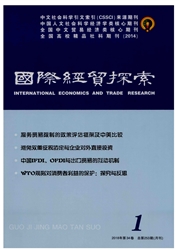

 中文摘要:
中文摘要:
文章基于跨期增长的RCK模型,构建国际贸易和国际资本流动下的环境库兹涅茨曲线理论框架,试图回答在开放经济下接受“污染转移”的发展中国家能否像发达国家一样经历相似的“污染~增长”路径?研究发现.落后国家存在EKC的条件是内生决定的,动态最优污染税率需随收入增加而不断提升。实证部分利用自回归分布滞后边界检验法(ARDL)在简约式EKC模型中加入国际贸易等变量,检验收入与中国环境质量之间长期协整关系.结果显示原先的“倒u型”关系或者不再存在或者形状变得更高和更窄,这表明中国的污染税率虽然随着收入的提高而不断严格,但与最优污染税率相比,依旧较为宽松。
 英文摘要:
英文摘要:
Based on the RCK model, this paper constructs a new theoretical framework of Environmental Kuznets Curve with international trade and capital mobility to attempt to answer the question that "can the developing countries which accept the 'pollution transfer' passively in an open economy experience the same 'pollution-growth' path as the developed countries?" It finds that the necessary condition of the EKC emergence in the growth path of a developing country is that the dynamic optimal pollution tax rate of the economy increases with the growth of per-capita income. The empirical study uses the autoregressive distributed lag boundary test (ARDL) in a simple EKC model added with the variable of international trade to inspect the cointegration relationship between income and environmental quality in China. The results show that the original "Inverted-U" relationship does not exist any longer, or the shape becomes higher and narrower, which means: although the environmental tax rate of China becomes stricter and stricter with the economic growth, compared with the optimal pollution tax rate, it is still very loose.
 同期刊论文项目
同期刊论文项目
 同项目期刊论文
同项目期刊论文
 期刊信息
期刊信息
